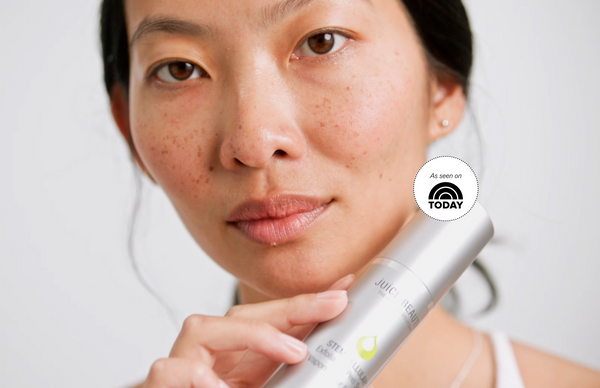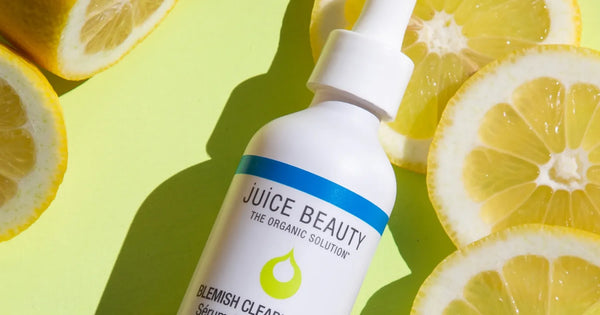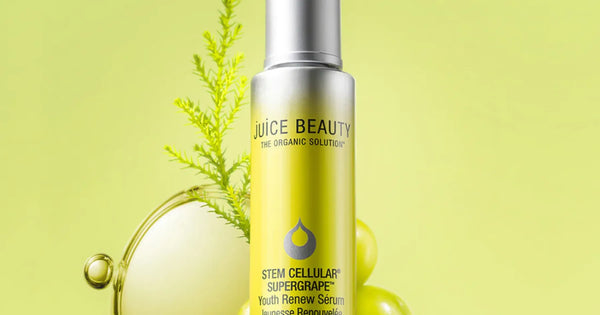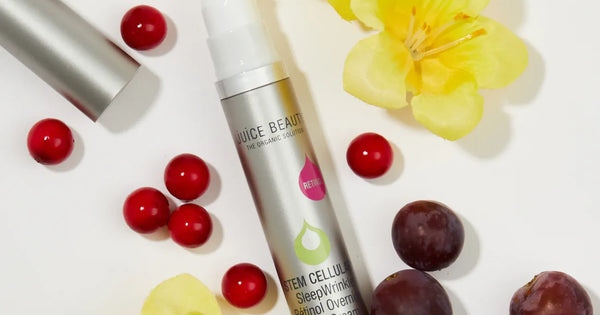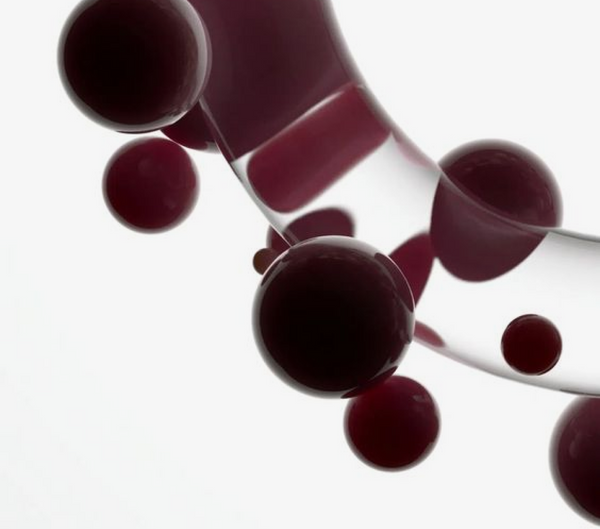If you’re a skincare enthusiast, you might have heard of retinol or the slightly lesser-known lactic acid.
Today, we’re taking a closer look at these two powerhouse ingredients. The burning question is: can these two skin superstars work together? Let’s jump right into how to make lactic acid and retinol work for you.
What Exactly Is Lactic Acid?
Lactic acid is a member of the alpha-hydroxy acid (AHA) family, and is known for its gentle yet effective exfoliating properties.
So, what makes it so special? A few things:
- It is naturally derived from milk, making it a favorite among those who prefer organic, natural skincare options.
- Lactic acid has larger molecules compared to other AHAs, which means it doesn’t penetrate as deeply. This makes it ideal for sensitive skin, as it can be less irritating.
- It’s a humectant, meaning it can help your skin retain much-needed moisture.
How Can Lactic Acid Benefit Your Skin?
Lactic acid is more than just an exfoliant. Here’s what it can do for your skin:
- Smooths out rough texture by gently dissolving the bonds between dead skin cells
- Brightens dull complexions by promoting cell turnover
- Reduces the appearance of fine lines and wrinkles
- Improves skin hydration, leaving you with a plump, dewy look
- Helps even out skin tone and reduce the look of pigmentation concerns
Our Juice Beauty Green Apple Peel Full Strength Exfoliating Mask harnesses the power of lactic acid alongside malic acid, willow bark, and aloe leaf juice to give your skin that coveted glow.
What Is Retinol?
You have probably heard of retinol before, but you may not know exactly what it is. Retinol, a form of vitamin A, is consistently hailed as the holy grail of anti-aging skincare, and with good reason.
So, what makes it so special?
- It is a smaller molecule that can penetrate deep into the skin.
- Retinol is converted to retinoic acid in the skin, which then works its magic.
- It is available over the counter, unlike its more potent prescription counterpart, tretinoin.
What Can Retinol Do for Your Skin?
Retinol is a highly versatile skincare ingredient. Here’s what it can do:
- Support proper collagen production, helping to firm and plump the skin
- Support skin cell turnover, revealing fresher, younger-looking skin
- Reduce the appearance of fine lines, wrinkles, and dark spots
- Help unclog pores, making it effective against acne
- Even out the look of your skin tone and texture
For those looking to incorporate retinol into their routine, our Stem Cellular Anti-Wrinkle Overnight Serum is an absolute game changer.
One of the best things about retinol is that it is available without a dermatologist’s prescription, but is still incredibly effective when it comes to fine lines, wrinkles, and dark spots.
Can Lactic Acid and Retinol Work Together?
Here’s the million-dollar question: can you use lactic acid and retinol in the same skincare routine? The answer might surprise you.
While both ingredients are potent on their own, using them together can lead to irritation, especially if you have ultra-sensitive skin. However, with the right approach and a little know-how, you really can reap the benefits of both.
When used correctly, this dynamic duo can:
- Provide comprehensive benefits without a prescription.
- Improve the look of your skin texture and tone.
- Tackle both surface-level and deeper skin concerns.
- Offer a one-two punch against pigmentation issues.
- Help maintain clear, radiant skin.
What Are Some Juice Beauty Products Containing Retinol and Lactic Acid?
If you’re ready to add lactic acid and retinol to your lineup, here are some Juice Beauty favorites to kickstart your journey:
- Stem Cellular Anti-Wrinkle Overnight Serum: A gentle retinol formula perfect for nighttime use.
- Green Apple Brightening Gel Cleanser: Reveal your skin’s natural brightness with this antioxidant-rich cleanser containing lactic acid, plant-based cleansers, malic acid, and sage leaf.
- Stem Cellular Exfoliating Peel Spray: A convenient spray featuring both lactic acid and retinol for a double dose of skincare goodness.
With Juice Beauty, you can rest assured that you’re getting effective formulas that bring you real results. With our Bio70+ technology, you're getting an antioxidant-rich, super juice base consisting of at least 70% organic ingredients in every product. This base sets the perfect environment for our potent active ingredients.
From soothing redness to easing dryness and wrinkles, our products are bringing real customers their dream results.
Are There Any Risks to Using Both Lactic Acid and Retinol?
While there are some potential risks, they are minimal, and can easily be thwarted by taking the proper precautions. These products can increase skin sensitivity, so if you already have sensitive skin, you probably don’t want to use these products everyday.
Instead, consider using them three to four times a week until your skin gets used to them.
Especially with retinol, you will have heightened sun sensitivity. This just means you need to be diligent about wearing your sunscreen — we love our Stem Cellular CC Cream Zinc SPF 30.
Lastly, if you aren’t using the products properly, you can run the risk of over-exfoliation. However, that is true with numerous product combinations, not just lattice acid and retinol.
What’s the Best Way To Start Using Lactic Acid and Retinol?
Want to enjoy the best of both worlds? Here are some tips:
Choose Your Products
Start off with lower concentrations of both ingredients and work your way up to higher concentrations once you know how your skin will react.
Patch Test
Always test out new products on a small area of skin first. A great place to do a patch test is on the inside of your elbow, where the skin is thinner, but a little potential irritation wouldn’t be a day ruiner.
Introduce Slowly
For any new product, it’s not a bad idea to begin by only using that product once or twice a week. You don’t want to shock your skin by suddenly using a brand-new product every single day.
Gradually Increase Frequency and Strength
If your skin tolerates the products well, start using them more frequently by slowly increasing usage. Likewise, if you’ve started off with a low concentration of retinol or lactic acid, once you finish your first container of product, you may consider trying out a higher concentration.
Can Everyone Use Lactic Acid and Retinol?
The good news is, most people can. While these ingredients are generally safe for most skin types, there are a few exceptions. Specifically, pregnant women should avoid retinol and consult their doctor before using lactic acid (although the latter is generally deemed safe).
If you have extremely sensitive or reactive skin, you should proceed with caution. Still, many people with sensitive skin have found that low concentrations of retinol are just fine, and lactic acid is one of the gentler AHAs out there.
Those with skin conditions like eczema or rosacea should consult a dermatologist before proceeding with any skincare routine.
How Can You Maximize the Benefits of Lactic Acid and Retinol?
To get the most out of these ingredients, there are a few essential tips to keep in mind:
- Be consistent: Results take time. Most users report that it takes six to eight weeks before they see any noticeable results. Stick with it — it’s worth it.
- Use sun protection: Both ingredients can increase sun sensitivity, so be ultra diligent about your SPF application. (We should all be doing this anyway, of course).
- Stay hydrated: Drink plenty of water and use a good moisturizer. Try our SPF 30 Matte Oil-Free Moisturizer for daytime use, and our Stem Cellular Anti-Wrinkle Ceramide Overnight Cream for nighttime use.
The Bottom Line
Lactic acid and retinol are both fantastic skincare ingredients that can work wonders for your skin.
While they can definitely be used together, it’s important to do so carefully and mindfully. Start slow, listen to your skin, and don’t be afraid to consult a skincare professional if you have concerns.
Sources:
Retinol: Cream, Serum, What It Is, Benefits, How To Use | Cleveland Clinic
Lactic Acid Chemical Peeling in Skin Disorders | Clinical, Cosmetic, and Investigational Dermatology

